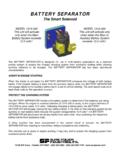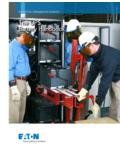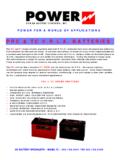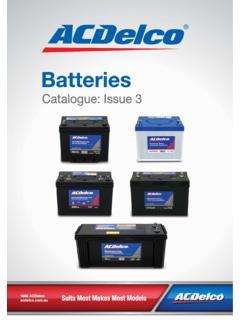Transcription of MATERIAL SAFETY DATA SHEET - The Battery World
1 MATERIAL SAFETY DATA SHEET . SECTION 1: PRODUCT AND MANUFACTACTURER. Product name: Sealed maintenance-free lead acid batteries Manufacturer: BAO TONG USA dba Battery World . Address: Hanqiang Street, Wuhan economic & technology development zone, WUHAN, China 430056. Tel: +86-27-84891320. US Office: 1032 E. Main Street, Alhambra, CA 91801. Tel: 626-289-5962. Fax: 626-576-2503. Date of Revision: 01/10/2014. SECTION 2: HAZARDOUS COMPONENTS. COMPONENTS %WEIGHT TLV LD50 ORAL LC50 INHALATION LC50 CONTACT. Lead (Pb, PbO2, PbSO4) About N/A (500) mg/Kg N/A N/A.
2 70%. Sulfuric Acid About 1 mg/m3 ( ) mg/Kg N/A N/A. 20%. Fiberglass Separator About 5% N/A N/A N/A N/A. ABS or PP About 5% N/A N/A N/A N/A. SECTION 3: PHYSICAL DATA. COMPONENTS DENSITY MELTING POINT SOLLUBILITY ODOR APPEARANCE. (H2O). Lead C (Boiling) None None Sliver-Gray Metal Lead Sulfate 1070 C (Boiling) 40 mg/l None White Powder (15 C). Lead Dioxide 290 C (Boiling) None None Brown Powder Sulfuric Acid About About 114 C (Boiling) 100% Acidic Clear Colorless Liquid Fiberglass Sep. N/A N/A SLIGHT TOXIC WHITE FIBROUS.
3 GLASS. ABS or PP N/A N/A NONE NO ODOR SOLID. Page 1 of 4. SECTION 4: PROTECTION. EXPOSURE PROTECTION COMMENTS. SKIN Rubber gloves, Apron, SAFETY Protective equipment must be worn if Battery is cracked shoes or otherwise damaged. RESPIRATORY Respirator (for lead) A respirator should be worn during reclaim operations if the TLV exceeded. EYES SAFETY goggles, Face Shield SECTION 5: FLAMMABILITY DATA. COMPONENTS FLASHPOINT EXPLOSIVE LIMITS COMMENTS. Lead None None Sulfuric Acid None None Hydrogen 259 4% - Sealed batteries can emit hydrogen only if over charged (float voltage> VPC).
4 The gas enters the air through the vent caps. To avoid the chance of a fire or explosion, keep sparks and other sources of ignition away from the Battery . Extinguishing Media: Dry chemical, foam, CO2. Fiberglass Sep. N/A N/A Toxic vapors may be released. In case of fire: wear self-contained breathing apparatus. 478 Polystyrene None N/A Temperatures over 300 C (572 F) may release combustible gases. In case of fire: wear positive pressure self-contained breathing apparatus. SECTION 6: REACTIVITY DATA. COMPONENT Lead/lead compounds STABILITY Stable INCOMPATIBILITY Potassium, carbides, sulfides, peroxides, phosphorus, sulfurs.
5 DECOMPOSITION PRODUCTS Oxides of lead and sulfur. CONDITIONS TO AVOID High temperature, Sparks and other sources of ignition. COMPONENT Sulfuric Acid STABILITY Stable at all temperatures POLYMERIZATION Will not polymerize INCOMPATIBILITY Reactive metals, strong bases, most organic compounds DECOMPOSITION PRODUCTS Sulfuric dioxide, trioxide, hydrogen sulfide, hydrogen CONDITIONS TO AVOID Prohibit smoking, sparks, etc. from Battery charging area. Avoid mixing acid with other chemicals. Page 2 of 4. SECTION 7: CONTROL MEASURES.
6 1. Store lead/acid batteries with adequate ventilation. Room ventilation is required for batteries utilized for standby power generation. Never recharge batteries in an unventilated, enclosed space. 2. Do not remove vent caps. Follow shipping and handling instructions that are applicable to the Battery type. To avoid damage to terminals and seals, do not double-stack industrial batteries. STEPS TO TAKE IN CASE OF LEAKS OR SPILLS. If sulfuric acid is spilled from a Battery , neutralize the acid with sodium bicarbonate (baking soda), sodium carbon (soda ash), or calcium oxide (lime).
7 Flush the area with water discard to the sewage systems. Do not allow unneutralized acid into the sewage system. WASTE DISPOSAL METHOD: Neutralized acid may be flushed down the sewer. Spent batteries must be treated as hazardous waste and disposed of according to local state, and federal regulations. A copy of this MATERIAL SAFETY data must be supplied to any scrap dealer or secondary smelter with Battery . ELECTRICAL SAFETY . Due to the Battery 's low internal resistance and high power density. High levels of short circuit can be developed across the Battery terminals.
8 Do not rest tools or cables on the Battery . Use insulated tools only. Follow all installation instruction and diagrams when installing or maintaining Battery systems. SECTION 8: HEALTH HAZARD DATA. LEAD: The toxic effects of lead are accumulative and slow to appear. It affects the kidneys, reproductive, and central nervous system. The symptoms of lead overexposure are anemia, vomiting, headache, stomach pain (lead colic), dizziness, loss of appetite, and muscle and joint pain. Exposure to lead from a Battery most often occurs during lead reclaim operations through the breathing or ingestion of lead dusts and fumes.
9 THIS DATA MUST BE PASSED TO ANY SCRAP OR SMELTER WHEN A Battery IS RESOLD. SULFURIC ACID: Sulfuric acid is a strong corrosive. Contact with acid can cause severe burns on the skin and in the eyes. Ingestion of sulfuric acid will cause GI tract burns. Acid can be release if the Battery case is damaged or if the vents are tampered with. FIBERGLASS SEPARATOR: Fibrous glass is an irritant of the upper respiratory tract, skin and eyes. For exposure up to 10F/CC use MSA Comfort with type H filter. Above 10F/CC up to 50F/CC use Ultra-Twin with type H filter.
10 NTP or OSHA does not consider this product carcinogenic. Page 3 of 4. SECTION 9: SULFURIC ACID PRECAUTIONS. INHALATION: Acid mist form formation process may cause respiratory irritation, remove from exposure and apply oxygen if breathing is difficult. SKIN CONTACT: Acid may cause irritation, burns or ulceration. Flush with plenty of soap and water, remove contaminated clothing, and see physician if contact area is large or if blisters form. EYE CONTACT: Acid may cause severe irritation, burns, cornea damage and blindness.






